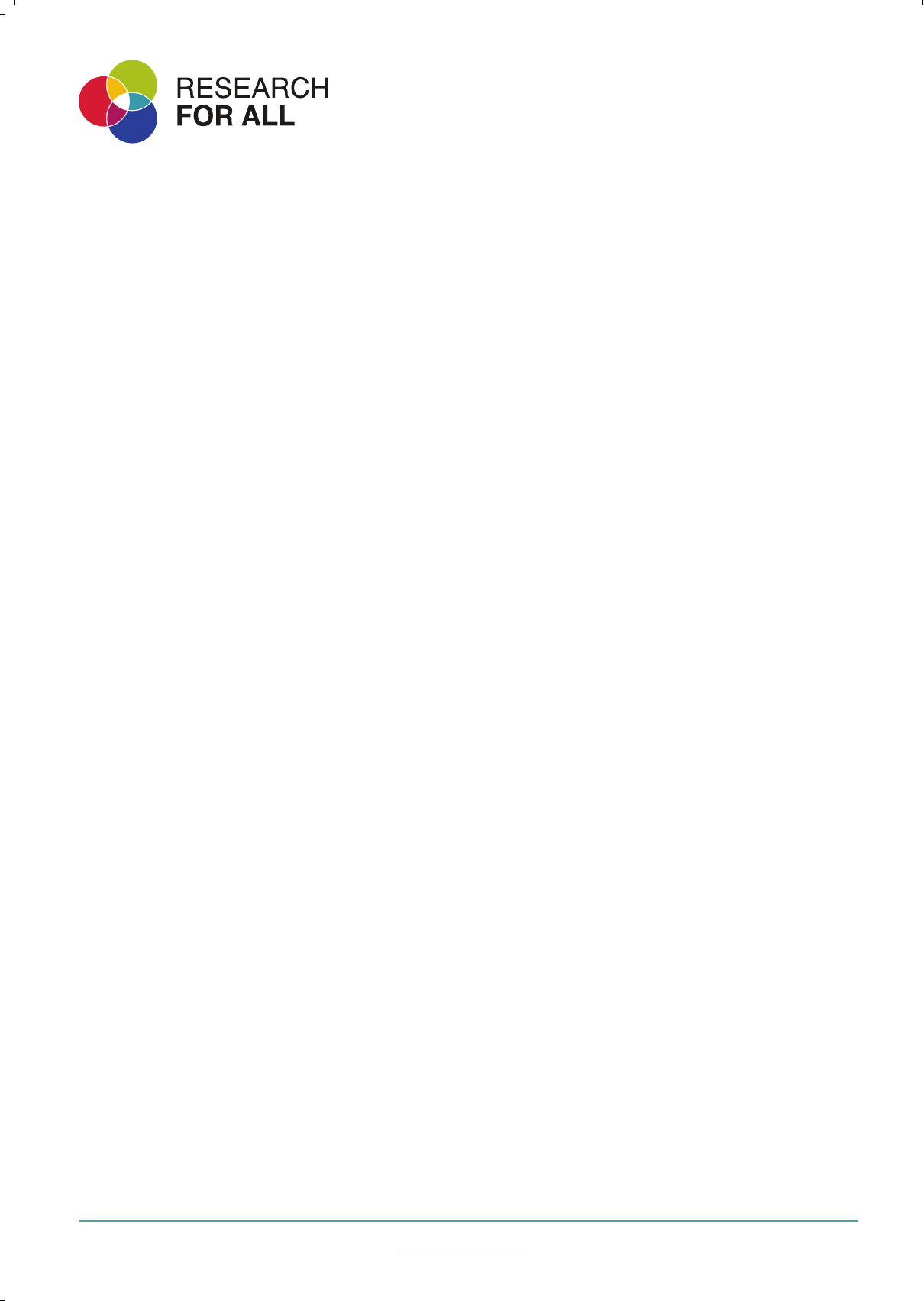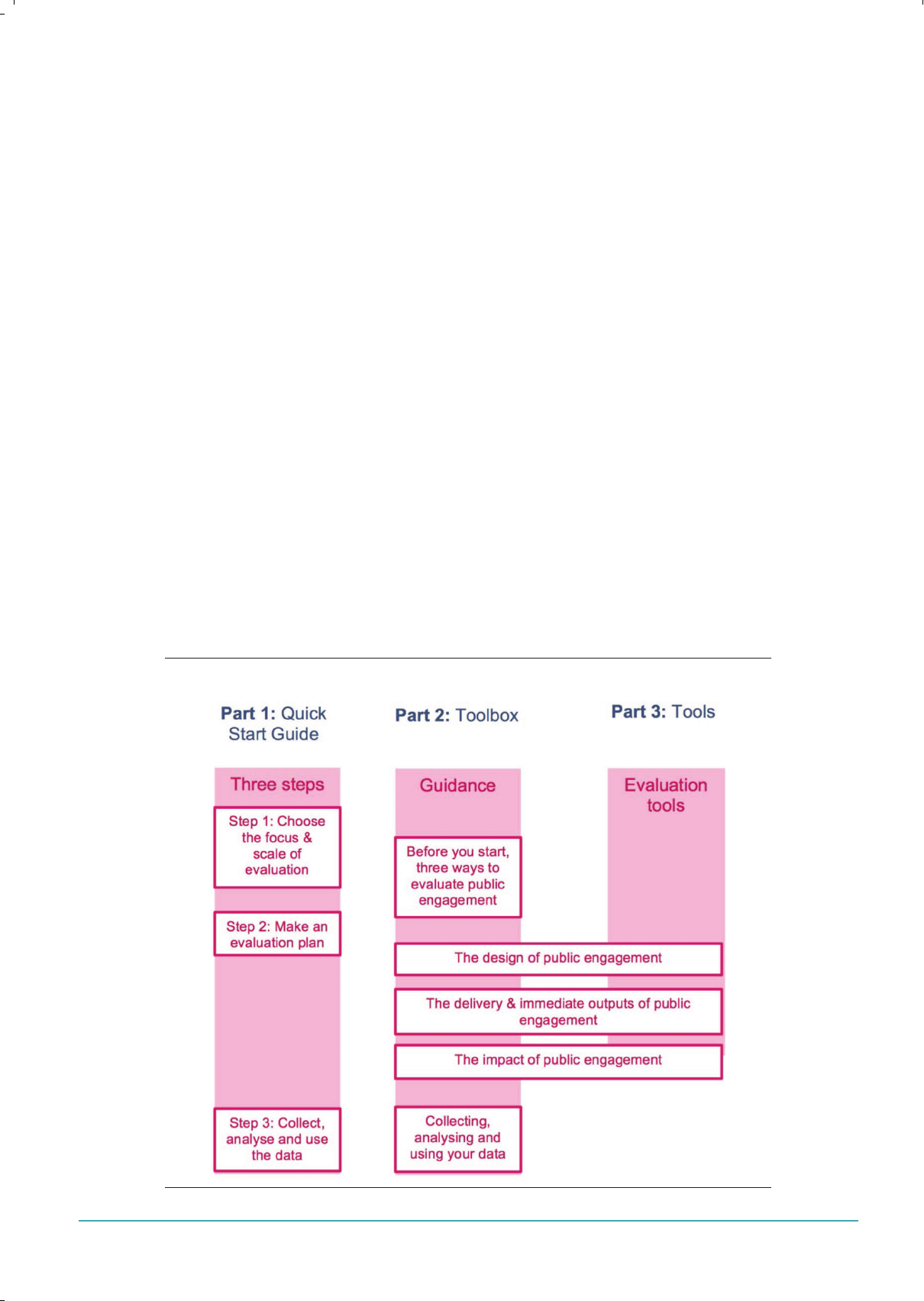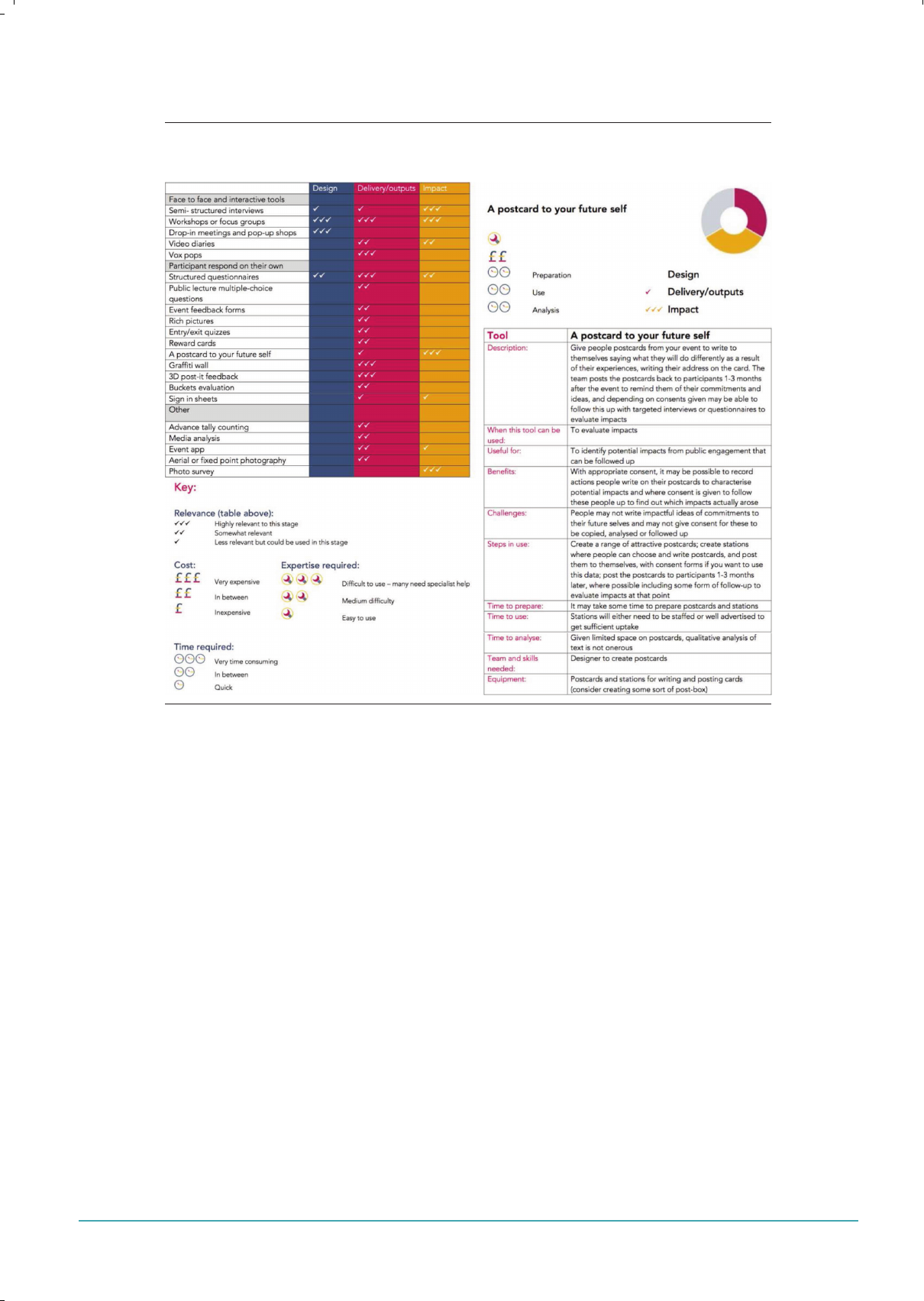
Reed, M.S., Duncan, S., Manners, P., Pound, D., Armitage, L., Frewer, L., Thorley, C.
and Frost, B. (2018) ‘A common standard for the evaluation of public engagement
with research’. Research for All, 2 (1): 143–162. DOI 10.1854 6/RFA.02.1.13.
* Corresponding author – email: mark.r[email protected] ©Copyright 2018 Reed, Duncan, Manners, Pound, Armitage, Frewer,
Thorley and Frost. This is an Open Access article distributed under the terms of the Creative Commons Attribution Licence, which
permits unrestricted use, distribution and reproduction in any medium, provided the original author and source are credited.
A common standard for the evaluation of public
engagement with research
Mark S. Reed* – Newcastle University, UK
Sophie Duncan – National Co-ordinating Centre for Public Engagement, UK
Paul Manners – National Co-ordinating Centre for Public Engagement, UK
Diana Pound – Dialogue Matters, UK
Lucy Armitage – Dialogue Matters, UK
Lynn Frewer – Newcastle University, UK
Charlotte Thorley – Queen Mary University of London, UK
Bryony Frost – Queen Mary University of London, UK
Abstract
Despite growing interest in public engagement with research, there are many
challenges to evaluating engagement. Evaluation ndings are rarely shared or
lead to demonstrable improvements in engagement practice. This has led to calls
for a common ‘evaluation standard’ to provide tools and guidance for evaluating
public engagement and driving good practice. This paper proposes just such
a standard. A conceptual framework summarizes the three main ways in which
evaluation can provide judgements about, and enhance the effectiveness of,
public engagement with research. A methodological framework is then proposed
to operationalize the conceptual framework. The standard is developed via a
literature review, semi-structured interviews at Queen Mary University of London
and an online survey. It is tested and rened in situ in a large public engagement
event and applied post hoc to a range of public engagement impact case studies
from the Research Excellence Framework. The goal is to standardize good practice
in the evaluation of public engagement, rather than to use standard evaluation
methods and indicators, given concerns from interviewees and the literature
about the validity of using standard methods or indicators to cover such a wide
range of engagement methods, designs, purposes and contexts. Adoption of the
proposed standard by funders of public engagement activities could promote
more widespread, high-quality evaluation, and facilitate longitudinal studies to
draw our lessons for the funding and practice of public engagement across the
higher education sector.
Keywords: responsible research and innovation; public participation; public
understanding of science; co-production; monitoring and evaluation

144 Mark S. Reed et al.
Research for All 2 (1) 2018
Key messages
●
A common ‘evaluation standard’ is proposed to provide tools and guidance
for evaluating public engagement with research, to promote good practice
and enable comparison between projects with different methods in different
engagement contexts, and to monitor changes in the effectiveness of
engagement across time and space.
●
Tools have been developed (and classied by cost, time and expertise required)
to evaluate the: (1) design of public engagement activities for a given purpose
and context; (2) delivery and outputs of public engagement; and (3) long-term
impacts of public engagement with research.
●
Systematic application of the proposed standard may enable better evaluation
of long-term impacts from public engagement under the Research Excellence
Framework, for example showing how engagement contributes to learning,
behaviour change and capacity building.
Introduction
Interest in public engagement with research has never been higher. The Higher
Education Funding Council for England (HEFCE) dened public engagement with
research as:
Specialists in higher education listening to, developing their understanding
of, and interacting with non-specialists. The ‘public’ includes individuals
and groups who do not currently have a formal relationship with an HEI
[higher education institution] through teaching, research or knowledge
transfer.
(HEFCE, 2006: 1)
It has been proposed that public engagement is a means of ‘ensuring that science
contributes to the common good’ (Wilsdon and Willis, 2004: 1) and restoring public
trust in science (Wynne, 2006). A major driver for this in the UK is the Research
Excellence Framework (REF), which evaluates the social and economic benets of
excellent research in the UK. Similar systems are being considered in other countries
that have signicant public investment in research (for example, Australia and Germany
are currently considering introducing impact into their national research evaluation
exercises, Excellence for Research in Australia and Forschungsrating; Reed, 2016). The
European Commission (2015) identies public engagement as one of the six ‘keys’ for
responsible research and innovation, and is considering ways of better evaluating the
impact of its research in the successor to Horizon 2020.
However, there are many challenges to the evaluation of public engagement.
As many public engagement activities are unplanned, there is often limited budget,
stafng or evaluation expertise available. Even when the resources are available to
evaluate public engagement, it may be difcult to motivate researchers to evaluate
their engagement practice (Rowe and Frewer, 2005; Burchell, 2015). Often, this is due to
resource constraints and a lack of structured techniques for identifying relevant publics
and other end users (Emery et al., 2015). Pathways from public engagement to impact
can be complex, non-linear and indirect (ESRC, 2009; ESRC, 2011; Molas-Gallart et al.,
2000). In addition, issues of time lags and attribution plague the evaluation of impacts

A common standard for the evaluation of public engagement with research 145
Research for All 2 (1) 2018
arising from public engagement, given the complex range of factors that may delay or
inuence impacts (Morris et al., 2011; Fazey et al., 2013; Fazey et al., 2014).
We dene the evaluation of public engagement with research as a process
that collects, analyses and reports data (via quantitative or qualitative means) on
the effectiveness of public engagement programmes and activities in terms of their
design (in relation to their context and purpose), delivery and immediate outputs, and
the benecial impacts that arise for participants and wider society, and subsequently
improves the effectiveness of future engagement and/or enables timely, reliable
and credible judgements to be made about the effectiveness of engagement (after
Stufebeam, 1968; Stufebeam, 2001; Patton, 1987). There is a normative assumption
within this denition that public engagement should produce benets for the economy
or society, and that evaluation should therefore assess the subjective worth or value of
engagement to different publics and stakeholders (Hart et al., 2009).
There are a large number of toolkits and resources available to guide the evaluation
of engagement projects (NCCPE, 2017a). Useful work has also been done to develop
indicators to allow institutions to evaluate and audit their engagement at a macro-
level (Hart et al., 2009; Neresini and Bucchi, 2011; Vargiu, 2014; European Commission,
2015). Despite this, there are claims that evaluation of public engagement tends to
be done rather poorly (not just in higher education, but in most sectors) (Bultitude,
2014), and that evaluation ndings are rarely shared widely or lead to demonstrable
changes in engagement practice (Davies and Heath, 2013). As a result, there are now
calls for the establishment of a common ‘evaluation standard’ to provide tools and
guidance for evaluating public engagement in order to promote good practice and
enable comparison between projects (Smithies, 2011; Neresini and Bucchi, 2011;
Bultitude, 2014). This paper is a rst step towards developing such a standard, which
can subsequently be applied to compare the efcacy of different methodological
approaches in different engagement contexts, and to monitor changes in the
effectiveness of public engagement across time and space.
The aim of the paper is to propose a linked conceptual and methodological
framework that can be used as a common evaluation standard for public engagement
projects across a wide range of possible contexts and purposes. The conceptual
framework summarizes the three main ways in which evaluation can provide judgements
about, and enhance the effectiveness of, public engagement. A methodological
framework is then proposed to operationalize the conceptual framework. The
development of the standard is informed by literature review, an online survey and semi-
structured interviews in Queen Mary University of London (QMUL), who commissioned
the development of a ‘public engagement evaluation toolkit’ to inform their work,
which could be used across the higher education sector. The standard is then tested
and rened in situ in a large public engagement event hosted by QMUL and post
hoc to a range of public engagement impact case studies from the 2014 Research
Excellence Framework.
Background
As greater emphasis is placed on public engagement with research, it is increasingly
important to be able to evaluate what works. An important starting point is to
understand the reasons why both researchers and publics wish to engage with each
other. It is not possible to evaluate ‘what works’ without rst understanding what is
being sought through public engagement.

146 Mark S. Reed et al.
Research for All 2 (1) 2018
A study of the views of scientists and publics about engagement in the context
of stem cell research identied three types of public engagement: education, dialogue
and participation in policymaking (Parry et al., 2012). The Department for Business,
Innovation and Skills (BIS, 2010) reframed these in their ‘public engagement triangle’
as transmitting, receiving and collaborating. Although widely used, these typologies of
engagement have limited theoretical basis. However, a new typology of engagement
published by Reed et al. (2017), argues that types of engagement can in theory be
distinguished by their mode and agency, leading to combinations of top-down and
bottom-up approaches for informing, consulting and collaborating with publics in
more or less co-productive ways (in line with NCCPE, 2017b):
• Informing, inspiring, and/or educating the public. Making research more
accessible, for example:
dissemination: making research ndings available and accessible to publics
inspiration and learning: where researchers share their research to inspire
curiosity and learning
training and education: where research is used to help build capacity of
individuals and groups in terms of knowledge, skills or other capacities
incentives: engagement with publics to incentivize public acceptance of
research.
• Consulting and actively listening to the public’s views, concerns and insights,
for example:
interaction: bringing researchers and research users together to learn from
each other
consultation: using focus groups, advisory groups or other mechanisms to
elicit insight and intelligence.
• Collaborating and working in partnership with the public to solve problems
together, drawing on each other’s expertise, for example:
deliberation and dialogue: working ‘upstream’ of new research or policy to
ensure that the direction of travel is informed by the public
doing research together: producing, synthesizing or interpreting research
ndings with publics, for example citizen science and collaborative research
facilitation: action research, where researchers enable the public to facilitate
desired change
enhancing knowledge: where research ndings are informed by multiple
perspectives and so are more robust and relevant
informing policy and practice: involving the public to ensure their insights,
expertise and aspirations inuence the evidence base for policy and practice.
Each of these three broad reasons for engaging publics is valid, and may be appropriate
depending on the context and purpose for which engagement is conducted. Contrary
to normative arguments that collaborative approaches should always be preferred
(see Arnstein’s (1969) ladder of participation), we adopt the approach taken by the
NCCPE and Reed et al. (2017), which takes a non-judgemental stance on engagement,
proposing that the type of engagement is matched to the context and purpose of
engagement, embracing communicative approaches where these are suited to the
context and purpose of engagement.
These different motivations for engaging with publics often lead to different
types of impacts. Impacts occur when public engagement gives rise to tangible
benets for people (such as enhanced well-being or educational attainment), and are
typically difcult to evidence. Research Councils UK denes research impact as ‘the

A common standard for the evaluation of public engagement with research 147
Research for All 2 (1) 2018
demonstrable contribution that excellent research makes to society and the economy’
(HEFCE, 2016: n.p.). Public engagement may give rise to a range of impacts, including
(after Hooper-Greenhill et al., 2003; Davies et al., 2005; Nutley et al., 2007; Belore and
Bennett, 2010; Morrin et al., 2011; Meagher, 2013; Facer and Enright, 2016):
1. instrumental impacts (for example, nancial revenues from widespread public
adoption of a new technology or policy change resulting from public pressure)
2. capacity-building impacts (for example, new skills)
3. attitudinal impacts (for example, a change in public attitudes towards issues that
have been researched)
4. conceptual impacts (for example, new understanding and awareness of issues
related to research)
5. enduring connectivity impacts (for example, follow-on interactions and lasting
relationships, such as future attendance at engagement events or opportunities
for researchers and members of the policy community to work more closely with
publics).
The ESRC (2009; 2011) emphasized the critical role of process design versus contexts in
determining the impacts arising from public engagement. This was explored empirically
by de Vente and colleagues (2016) and theoretically by Reed and others (2017), to
identify design principles that could increase the likelihood that public engagement
processes lead to impacts. These studies emphasize the importance of evaluating
the design of public engagement processes. If design is evaluated a priori, or early
in a public engagement project (that is, formative evaluation), it may be possible to
adapt the design of engagement to better address contextual factors and increase the
likelihood of impacts arising from the work.
Sciencewise (2015) took this a step further, differentiating between the design,
context and delivery of public engagement as key determinants of impact. They
argued that a well-designed process that is well suited to its context may still fail
to achieve impacts if poorly delivered. As such, it is vital to evaluate the delivery of
public engagements and the immediate outcomes that arise from effective delivery, in
addition to evaluating the eventual impacts of engagement. In addition to evaluating
the design of engagement, evaluating the pathway to impact in this way can further aid
the adaptation of engagement processes to ensure they achieve impacts (Reed, 2016).
Building on this, it is possible to propose a series of principles to underpin
the evaluation of public engagement (adapted from Pearce et al. (2007) and
Sciencewise (2015)):
• Start early: evaluate engagement throughout the design and delivery of
the project.
• Be clear: on purpose, scope, approach, levels of engagement in, and limits of,
the evaluation.
• Use evaluation methodologies that are rigorous and t for purpose.
• Seek understanding and learning, rather than apportioning blame or evaluating
merely to satisfy funder requirements.
• Facilitate ows of knowledge, information and benets between researchers
and publics.
• Build trust: partnerships deepen and develop through extended reciprocity and
improved access.
• Respect condentiality: protecting the sensitivity of data collected, and avoiding
personal or reputational harm.

148 Mark S. Reed et al.
Research for All 2 (1) 2018
• Avoid conicts of interest: including privileged access to information not being
used for future competitive advantage.
• Be proportionate: using sufcient resources to probe in sufcient depth to meet
evaluation objectives.
• Be transparent: the evaluation should be explained to participants and
stakeholders, and evaluation ndings published.
• Be practical: evaluation data sought can be collected, assessed and reported
within timescale and budget.
• Make it useful: evaluation ndings should be reported in accessible language
and in a form that is useful for learning and to provide evidence of impacts, what
works, and lessons for the future.
• Be credible: use evaluation frameworks and methods that deliver intended
outcomes.
In certain circumstances, in particular summative evaluations (that provide judgements
of engagement and impact) for reporting to funders in large projects, it may also be
important for the evaluation to be independent (from commissioners, funders, delivery
team and participants). However, the focus of this paper is to create a standard that may
be used by both researchers who wish to evaluate their own practice and independent
evaluators.
A range of evaluation methodologies have been developed to enact these
principles. Warburton (2008) and Sciencewise (2015) describe a methodological
framework for evaluating public engagement that describes the purpose for which
engagement is being used, the scope and design of the engagement process, the
people who are engaged and the context in which engagement takes place. They
suggest that there should be three stages in any evaluation of public engagement:
baseline assessment, interim assessment of design and delivery, and nal assessment
of the overall project and its impact.
Logic models (such as logical framework analysis or ‘logframes’; Gasper,
2000) and ‘theory of change’ (Quinn and Cameron, 1988) are more widely applied
in international development settings, but they may also be used to evaluate public
engagement.Each of these approaches requires a clear understanding of the desired
or planned change, ‘long-term outcomes’ or goals that are sought from engagement.
Bothapproaches then help teams to identify the steps that are needed to reach these
goals (including the identication of specic inputs and activities), and help them to
articulate and interrogate the assumptions that lie behind each of these steps in a
change process. Each approach also species milestones and indicators that can be
used to monitor progress towards impacts.
Contribution analysis takes a logic model approach (Morton, 2015). It attempts
to address issues of attribution in evaluation by assembling evidence to validate the
logic model, including an examination of alternative explanations of impact. First, a
pathway to impact is mapped, then assumptions and risks are identied for each stage
of the pathway and impact indicators are identied. Using these indicators, evidence
is collected for each part of the pathway and a ‘contribution story’ is written. In doing
this, contribution analysis attempts to build a credible case about what difference is
being made as a result of public engagement.
Similarly, outcome mapping (Earl et al., 2001) considers how public engagement
might directly inuence the behaviour of individuals, groups and organizations, known
as ‘boundary partners’, recognizing the many factors that are outside the control of
the project. Outcome mapping therefore seeks to understand the contribution made
by a project to impact, rather than claiming denitive attribution. Desired changes in

A common standard for the evaluation of public engagement with research 149
Research for All 2 (1) 2018
boundary partners are rst identied, strategies for supporting change are developed
and a monitoring system to track changes is used to evaluate engagement.
Realist evaluation (Pawson et al., 2005) asks what works for whom in what
circumstances and in what respects, and how, using a mixed methods approach,
drawing on quantitative, qualitative, comparative and narrative evidence, as well as
grey literature and the insights of programme staff. The ‘adjudicator’ then evaluates to
what extent the data collected can be used to build or prove a theory of change or a
pattern of outcomes.
The ‘most signicant change’ technique (Davies and Dart, 2005) is a qualitative
and participatory evaluation method that uses stories of change to assess the impact
of public engagement. Rather than measuring indicators, stories are sought about
specic changes that have occurred as a result of engagement, and these stories are
then compared and analysed through multi-stakeholder discussion to decide which
changes are most credible and important.
Finally, it is worth sounding a cautionary note that many of the theories,
assumptions and methods discussed above align closely with the historic ‘public
understanding of science’ movement. There is limited evidence that this movement
increased public acceptance or trust in controversial research applications (such as
genetically modied foods), but it has been credited with opening research activities
up to public scrutiny.
Methods
A literature review, drawing upon peer-reviewed and grey literature, summarized in the
previous section, led to the development of an initial evaluation framework. Arising
from this review were several key principles:
• A reective approach to evaluation that builds it into project planning and
delivery is essential – it should not be left until the end.
• It is helpful to guide people through a set of prompts to encourage them to
make explicit their assumptions about change – and to encourage them to
revisit these.
• It helps to differentiate between inputs, outputs, outcomes and impacts as
part of this.
• A ‘logical framework’ approach is particularly helpful in structuring the key
questions/considerations people need to engage with to design and execute
quality evaluation.
QMUL co-authors commissioned the research underpinning this article, and helped
to identify likely users of a toolkit, who could help scope and shape its development.
Semi-structured interviews were conducted by the lead author with ve QMUL staff
(who are not co-authors on this paper). A purposive sample was selective based on
experience of public engagement, representing a range of disciplines and roles
(professional services, events management, ethics, physics and geography) and levels
of seniority (from PhD student to pro-vice-chancellor). Interview topics included:
discussion of their role and experience of public participation, elements needed in a
public engagement evaluation toolkit, and examples of good practice. Based on these
examples, respondents were asked to identify generalizable good practice principles.
Interviews with QMUL staff were supplemented with an online survey completed by
ten further respondents from other UK universities, who self-identied themselves as
potential users of the toolkit via social media. They were asked a range of questions

150 Mark S. Reed et al.
Research for All 2 (1) 2018
under each of the topics used in the semi-structured interviews, including: the most
valuable resources they drew upon to inform their evaluation of public engagement,
methods and approaches for evaluating public engagement, key challenges for
evaluating public engagement (that the toolkit could address); they were also asked to
identify indicators of successful public engagement.
A thematic analysis of semi-structured interviews and open survey questions
was used to rene the conceptual framework and scope the specication of a
public engagement evaluation toolkit. The structure of the toolkit was based on the
conceptual framework, and its purpose and functionality was based on feedback from
the semi-structured interviews.
The toolkit was then trialled at a major UK public engagement festival (the
Festival of Communities, organized by QMUL from 21 May to 4 June 2016 in Tower
Hamlets, London). Evaluation data collected at the festival ranged from qualitative
survey responses and social media commentary to visitor counts and demographics,
and was analysed using qualitative (thematic and content analysis) and quantitative
(descriptive statistics) techniques.
To test its wider applicability, the framework was applied retrospectively to
QMUL’s Research Excellence Framework (REF) impact case studies from 2014, focusing
on those that involved public engagement, and sourced from the HEFCE impact
case study database. Application of the framework to these case studies aimed to
explore how the use of the toolkit could both improve the design of the engagement
processes, and better evidence if and how impacts had been achieved.
Feedback from QMUL festival organizers who trialled the toolkit, and insights
from its application to REF case studies, was used to further rene the toolkit. The
resulting toolkit was then reviewed by public engagement specialists and potential
users from drama, physics and geography at QMUL, and further rened in response to
their feedback.
A framework for evaluating public engagement
This section describes a linked conceptual and methodological framework for the
evaluation of public engagement, as it was developed through this research. The
conceptual framework summarizes the three main ways in which evaluation can
provide judgements about, and enhance the effectiveness of, public engagement (see
Figure 1):
1. Evaluate the design of public engagement activities for a given purpose and
context: to what extent is/was the design of the public engagement process and
activities appropriate for the context and purpose of engagement?
2. Evaluate the delivery and immediate outputs of public engagement: to what extent
do/did the delivery of the public engagement process and activities represent
good practice and lead to the intended outputs?
3. Evaluate the impacts of engagement: to what extent do/did engagement activities
lead to planned (or other) benets for target publics and researchers?
This is then operationalized via a methodological framework, based on a logic model
approach (see Figure 2), as described below.

A common standard for the evaluation of public engagement with research 151
Research for All 2 (1) 2018
Figure 1: Three ways to evaluate public engagement
Figure 2: Public engagement evaluation planning template

152 Mark S. Reed et al.
Research for All 2 (1) 2018
Evaluate the design of public engagement activities
Many of the most common mistakes in public engagement can easily be avoided if
formative evaluation of the design is done at an early stage. It is important to evaluate
the design of planned public engagement against good practice principles, and check
if activities are appropriate to the context and likely to meet intended goals.
As shown in the case study that follows in the next section, using the evaluation
planning template in Figure 2, it is possible to evaluate the design of planned public
engagement:
1. Does the design follow good practice, underpinned by sound ethics and avoid
known issues that commonly lead to failure?
2. Is the design appropriate and relevant for the context in which it is taking place,
including the needs, priorities and expectations of those who take part?
Are any of these factors likely to present challenges for the planned approach to
public engagement? If the evaluation of design is done prior to engagement, it may
be possible to improve the design before delivering the project.
Evaluate the delivery and immediate outputs of public engagement
Public engagement is often assessed in terms of the number and range of people taking
part. However, it is just as important to know about the quality of the engagement:
good delivery of public engagement results in all sorts of positive outputs, and poor-
quality engagement can achieve little, and in some cases make things worse.
Using the evaluation planning template in Figure 2, it is possible to identify
specic outputs that researchers and/or publics would expect to see as a result of
engagement (for example, new learning and awareness, or changes in behaviour).
Then indicators can be identied that would show progress towards these outputs. It
is useful to systematically identify outputs, and associated indicators and tools linked
to each planned engagement activity.
In contrast to most logic models, the proposed standard moves from design to
delivery and outputs, and then impacts (missing outcomes). This was done in response
to feedback from users unfamiliar with evaluation methods, who found it difcult to
understand the difference between outputs, outcomes and impacts. As a result, we
do not provide an academic discussion of the differences between these terms here,
to avoid further confusion given the conceptual overlaps that exist between them.
Instead, we provide explanatory examples of outputs in the case study below, and
accept that this term can be used loosely in practice, without compromising the rigour
of the evaluation.
Evaluate the impacts of engagement
The third way that we are proposing to evaluate public engagement is to focus on the
impacts of engagement. If the goal is to report benets arising from public engagement,
it will be necessary to consider the sorts of impacts that might be expected as a result
of the engagement. Depending on how indirect and long term these impacts are, it
will typically be necessary to include evaluation activities sometime after the original
project is completed (where resources permit). These activities can build on any initial
evaluation to capture longer-term impacts. Although many researchers tend to look
primarily for instrumental impacts, the previous section of this paper has shown other
types of impacts that may arise from public engagement with research.

A common standard for the evaluation of public engagement with research 153
Research for All 2 (1) 2018
Once impact goals have been identied, it is possible to use the evaluation
planning template in Figure 2 to assign indicators to track progress towards each of
these impacts, using relevant tools.
Collect, analyse and report evaluation data
With an evaluation plan in place, it is now possible to start collecting and analysing
data for each of the selected indicators, using the tools chosen from a menu in the
toolkit. There are almost always opportunities to learn from the experience of doing
public engagement, and an effective evaluation will provide lessons that can enhance
future practice. Larger, longer-term projects can consider how they can improve their
practice using the evaluation planning template in Figure 2. This uses a trafc light
system to colour code each indicator to show if it is ‘on track’ (green), ‘improving’
(amber) or ‘not on track’ (red). The tool has space to record reasons for these
assessments, and what can be done to improve the public engagement approach, or
address unexpected challenges. To enable this, the trafc light system is adapted from
a project management tool, and combined with the three logic model components
(evaluate the design, evaluate the delivery and immediate outcomes, and evaluate the
impacts of engagement) covered in Figure 2.
Results
Figure 3 shows the structure and contents of the toolkit that was developed. Figure
4 shows the menu of tools, an example tool and the key to interpret symbols used in
the tool.
Figure 3: Structure and content of the public engagement evaluation toolkit

154 Mark S. Reed et al.
Research for All 2 (1) 2018
Figure 4: Menu of tools, an example tool and the key to interpret symbols used
in the tool
Interview ndings
Thematic analysis of data from interviews with QMUL staff showed that those
interviewed perceived formative feedback from evaluation to be more important than
summative feedback, although it was recognized that both would be necessary in the
toolkit that would be developed for them. The perceived importance of formative
feedback was in recognition of its value in enhancing engagement practice during the
engagement process. An emphasis was placed on kinaesthetic evaluation techniques,
for example involving participants placing counters in buckets, sticking shapes on walls
or Post-it notes on 3D shapes to evaluate public engagement activities. Consistent
with concerns raised by the Wellcome Trust (Burchell, 2015), there was a desire for
evaluation techniques that could be used simply and quickly by researchers: ‘pick
up and play’, as one interviewee put it. With this in mind, it was suggested by one
interviewee that it should be possible for non-academic support staff to be able to use
the evaluation toolkit on behalf of researchers. While there was support for a common
evaluation standard that could enable comparison between projects, interviewees also
emphasized the need to be able to select goals, indicators and tools for a wide variety
of purposes and contexts: ‘tools not rules’, as one interviewee put it. For this reason, the
evaluation planning template in Figure 2 was made as open and exible as possible, so
that users can identify unique goals for projects, with appropriate indicators tailored to
measure progress towards those goals. The toolkit does, however, provide suggestions
of methodological tools that can be used to collect data for a range of indicators, and

A common standard for the evaluation of public engagement with research 155
Research for All 2 (1) 2018
so monitor progress towards goals. Interviewees wanted to see a mixture of tools that
could provide quantitative and qualitative data. The toolkit is designed to make it easy
to select relevant tools, using an index of tools and/or a graphical key at the start of
each tool. Both the index and graphical key show users which part of the engagement
process the tool is most suited to (for example, evaluating the design of engagement
versus evaluating impact), and the time, expertise and resources likely to be required
in its use.
In situ case study application
Interview ndings were combined with insights from the literature review to create
a draft public engagement evaluation toolkit, which was trialled at a major public
engagement event, the QMUL Festival of Communities, in Tower Hamlets, London.
As part of this, a range of tools were trialled from the toolkit, from each of the three
major sections: evaluating the design of engagement, its delivery and immediate
outputs, and its impact. This was a collaboration between QMUL and local community
organizations aimed at enabling cohesion between different local communities and
fostering long-term relationships between these communities and the university:
• Evaluate the design of public engagement activities: Before running its rst
Festival of Communities in 2016, QMUL evaluated the design of the event using
a focus group with community leaders and academics. Participants discussed
the goals of the festival, target publics, risks and assumptions associated with
planned activities, and whether or not these activities were likely to achieve the
goals of the festival for each of the target publics. Community leaders provided
valuable feedback about contextual factors that may limit the success of the
festival, such as language barriers and objections to noise from surrounding
communities. Where plans were already in place to adapt the design of the
festival to this context, these were communicated to participants (for example,
coordinating the location and timing of noisy activities with the local mosque)
and, where necessary, the design of activities was adapted (for example,
recruiting student volunteers with relevant language skills to assist stallholders).
• Evaluate the delivery and immediate outputs of public engagement: In
QMUL’s Festival of Communities, two evaluation tools were used to assess
progress towards the immediate goal of having engaged a wide range of publics
(many for the rst time). These tools were designed to collect data that could
indicate the balance of participants from different communities, ages, genders
and backgrounds, and the proportion who were engaging with research for the
rst time. Face-to-face surveys were carried out by student volunteers with a
random sample of participants during family ‘fun days’, and questionnaires were
administered at a selection of other festival events. During fun days, participants
received reward cards and could collect stickers (different colours for different
activities) for doing something new, with completed cards being entered in a
prize draw.
• Evaluate the impacts of engagement: The impact goals of the QMUL
Festival of Communities included an increased acceptance of different cultures
within local communities, and to generate long-term relationships between
the university and local communities. Indicators of success for these impacts
included evidence of more positive attitudes towards different cultures and the
university from among community members, and increased engagement with
QMUL (for example, via future events) after the festival. The tools that were used

156 Mark S. Reed et al.
Research for All 2 (1) 2018
to measure progress towards these goals via these indicators were the collation
of comments on social and other media linked to the festival, and a follow-up
survey (pertaining to this and other impacts) with those who signed up for email
updates at the festival and those commenting on the festival via social media.
Attendance at future events will also be monitored, with questions in future
evaluation forms asking about previous engagement with QMUL, including
specic reference to the festival.
• Collect, analyse and report evaluation data: Data collection at the QMUL
Festival of Communities was done by an evaluation team supported by student
volunteers for fun days, and by QMUL event organizers throughout the rest of
the festival. Across the festival, sampling was used to collect data efciently
while representing the widest possible range of public engagement activities.
For example, ve stalls were selected at the fun day to represent the main types
of activities on offer, and visitor counts were conducted in 15-minute periods
spread out across the day, including visual assessments of diversity criteria (for
example, gender and broad age categories). Examples of data analysis from
the QMUL Festival of Communities include content analysis of social media
comments linked to the festival, and quantitative (descriptive statistics) and
qualitative (thematic analysis) analysis of data from questionnaires. Evaluation
ndings are being used to communicate outputs and impacts from the festival to
stakeholders and to shape future festival designs. Formative feedback from the
evaluation has been supplemented via interviews with members of the organizing
team, and used to formulate specic recommendations for improvements that
can be made for future events.
Post-hoc application to other case studies
Finally, the revised toolkit was tested post hoc on a wider range of public engagement
programmes and activities, described in the QMUL REF impact case studies. The
purpose of this step was to test the wider applicability of the evaluation standard, and
test its applicability as a post-hoc tool, not to provide guidance on how to evaluate
public engagement in REF. Of the 77 case studies submitted, 43 referenced keywords
associated with public engagement (as detailed in NCCPE, 2016).
Analysis of these ‘public engagement’-relevant case studies provided insights
into the types of impact claimed through public engagement, which predominantly
focused on enriching public discourse and understanding – often through media
appearances. While there were several case studies where public engagement
played the key role in achieving impact, many included public engagement alongside
substantial policy engagement and/or engagement with practitioners. The public
was primarily referred to as ‘one group’, with few attempts to dene their target
publics. The evidence provided for impact included detailed lists of the number of
outlets, with the size of audience also featuring in many of the case studies. Evidence
was also provided through expert testimonial, and in a few cases through audience
feedback. This is reected in the analysis of the REF case studies completed by the
NCCPE (2016) that illustrated the role of public engagement in creating impacts
relevant to the REF.
The case studies are specically framed around the criteria for the UK’s Research
Excellence Framework (signicance and reach of impacts arising from excellent
research, which were used as criteria in 2014 and will be used again in 2021), and
do not typically provide details about how they evaluated engagement. However, we

A common standard for the evaluation of public engagement with research 157
Research for All 2 (1) 2018
can make some assumptions about the evaluation approach based on the evidence
provided in the case study. Retrospectively applying the toolkit principles to these case
studies suggests that evaluation could be strengthened to develop more effective
approaches to public engagement, including more clearly dened aims and a better
understanding of audiences/participants. In addition, the toolkit would enable more
convincing evidence of impact to be assessed, by creating baseline data to assess
progress over time, by better understanding the nature of those participating in the
engagement activities, and by providing approaches to enable researchers to explore
the nature of any change on those engaged.
The analysis of the case studies, albeit limited by the nature of the REF case
studies, suggests that the toolkit can provide a useful framework for evaluating public
engagement, improving engagement practice and evidencing impact (including for
the REF).
Discussion
In its initial form, those who used the draft toolkit in situ found the resulting evaluation
plan too detailed and difcult to follow. In response to this feedback, backed up by
calls from interviewees, all the sections of the evaluation plan that could be completed
by users were removed except for the template in Figure 2, and a cut-down version
of this table was provided in an initial ‘quick-start guide’, providing users with quick
access to basic evaluation planning over two pages.
This feedback, evidence from interviews and literature, and the analysis of the
REF case studies suggests that the quality of engagement practice and the rigour of
impact assessment could be greatly enhanced by investing in evaluation training and
capacity building.
Additionally, the review of the REF case studies identies some particular
challenges arising from the types of engagement currently being practised in higher
education, reinforcing the ndings of the NCCPE’s review of the whole REF case study
sample (NCCPE, 2016). There is a need to evidence more effectively how engagement
through the media actually inspires learning, behaviour change or capacity building.
Most case studies assume that appearing in the media is an impact in itself, and
therefore do not gather further evaluative data showing how ideas from the research
inuenced public discourse. Conceptual impacts were the most common type of
impacts claimed in public engagement-related case studies in REF 2014. However, in
future, consideration could be given to the broader range of impact types that may be
achieved through public engagement.
The process of developing a public engagement evaluation standard has
reinforced a number of messages that have arisen repeatedly in the literature:
• Clarity about the purpose(s) of your planned evaluation is essential (for example,
to inform more effective design or execution of engagement activities, to nd
out what happened as a consequence). The REF case studies illustrated a need
for a more effective approach to evaluation for engagement activities, which
would improve the effectiveness of the activities, and evidence what change has
happened as a result.
• It helps to think ‘systemically’: projects always exist within a wider context. Being
clear about that context and how your project contributes to a wider system is
important in making robust judgements about its effectiveness.
• Usually you are making a ‘contribution’, rather than achieving the impact through
your intervention alone. Several of the REF case studies analysed evidenced

158 Mark S. Reed et al.
Research for All 2 (1) 2018
impact where the direct link between the research and the impact was not clear.
In several of these case studies, it would be interesting to see a wider context
for the impact claimed, with a recognition that this may be a contribution to the
desired change, rather than the only factor in achieving the impact.
• Evaluating public engagement is particularly challenging because its impacts are
often subtle (on understanding, attitudes or values); these are hard to measure
and they change over time, and it is often challenging to isolate the contribution
made by the activity being evaluated. Very few of the REF case studies made any
attempt to evidence long-term impacts arising from public engagement.
• Different disciplinary and practice areas have rather different philosophical,
epistemological and practical frameworks guiding their practice (often implicitly).
These need to be acknowledged – while some fundamental principles cut
across all disciplines, it is important to develop different approaches and ways of
describing evaluation that are ‘tuned in’ to people’s professional contexts and
mindsets. The review of the REF case studies revealed signicant differences
in how researchers in the different panels chose to describe and rationalize
their engagement activities, with those in the sciences usually seeking to raise
public awareness of their research through the media, and those in the arts and
humanities more often working in partnership to weave their public engagement
activity into a more integrated approach to inuencing cultural policy and
practice.
Conclusion
This paper has developed a set of common standards for the evaluation of public
engagement with research, consisting of three ways of evaluating engagement
linked to a logic model. The goal is to provide a framework that explains what should
be considered when evaluating public engagement with research, rather than to
use standard evaluation methods and indicators, given concerns from users and the
literature about the validity of using standard methods or indicators to cover such a
wide range of engagement methods, designs, purposes and contexts. The adoption
of such a standard by funders of public engagement activities could promote more
widespread evaluation of public engagement. In this way, it may be possible to
create an evaluation data repository that could facilitate longitudinal studies and
enable lessons to be drawn for the funding and practice of public engagement
across the sector.
Acknowledgements
This research was funded by the Higher Education Funding Council for England’s
Higher Education Innovation Fund and the Wellcome Trust’s Institutional Strategic
Support Fund, awarded to Queen Mary University of London. Thanks to Peter McOwan,
Vice Principal (Public Engagement and Student Enterprise) at QMUL who led the
commissioning of this research. Thanks to Gene Rowe for constructive feedback on an
earlier draft of this paper. The project was delivered in partnership with the NCCPE.
Figure design by Anna Sutherland.

A common standard for the evaluation of public engagement with research 159
Research for All 2 (1) 2018
Notes on the contributors
Mark S. Reed is a transdisciplinary researcher specializing in social innovation, research
impact and stakeholder participation in agri-food systems. He is Professor of Social
Innovation at Newcastle University, and a Visiting Professor at the University of Leeds
and Birmingham City University. He has written more than 130 publications, which have
been cited more than 10,000 times, and does research impact training through his
spin-out company, Fast Track Impact.
Sophie Duncan is Deputy Director of the National Co-ordinating Centre for Public
Engagement. She has over 20 years’ experience of public engagement, including
leading engagement campaigns for the BBC, managing national programmes for
Science Year, and curating exhibitions for the Science Museum, London. Sophie is
committed to the development of high-quality engagement, and the strategic use of
evaluation to improve and evidence practice. She is co-editor of Research for All.
Paul Manners is Associate Professor in Public Engagement at UWE Bristol and director
of the UK’s National Co-ordinating Centre for Public Engagement (NCCPE).Before
founding the NCCPE, Paul trained as a secondary English teacher and, after teaching
for ve years, joined the BBC, where his credits include the long-running BBC2 series
Rough Science and a variety of national learning campaigns.
Diana Pound is a participation expert and founding director of Dialogue Matters.
She has two decades’ experience designing and facilitating environmental dialogue
in research or resource management, at local to international levels and in over 25
countries. She researches good practice, advises governments, UN conventions and
other organizations, has trained about 2,000 people in good practice and won the
2015 CIEEM Best Practice award.
Lucy Armitage is a senior facilitator and trainer for Dialogue Matters. She has
facilitated dialogue in research and resource management contexts, including in
tense and difcult situations. On behalf of Dialogue Matters she is a trainer for the
British Council’s internationally esteemed Researcher Connect course, and has trained
researchers in the UK, China and Brazil.
Lynn Frewer is Professor of Food and Society in the School of Natural and Environmental
Sciences at Newcastle University in the UK. Previously Lynn was Professor of Food
Safety and Consumer Behaviour at Wageningen University in the Netherlands. Lynn
has worked at the Institute of Food Research (Norwich and Reading), the Institute of
Psychiatry in London and the University of Port Moresby in Papua New Guinea. She has
interests in transdisciplinary research focused on food security.
Charlotte Thorley is a freelance public engagement specialist and researcher based
in Brussels. From 2012–16 she established the nationally recognized Centre for Public
Engagement at Queen Mary University of London, as well as undertaking her doctoral
research exploring the role of the scientist in engagement activities.She is Honorary
Senior Research Associate at the UCL Institute of Education, University College London.
Bryony Frost has spent several years working in science communication and public
engagement. After studying for a physics degree and an MSc in science communication
at Imperial College London, Bryony has worked at Queen Mary University of London in
several roles, including as an outreach ofcer and in the Centre for Public Engagement,
where she worked on support and advice, training and evaluation.

160 Mark S. Reed et al.
Research for All 2 (1) 2018
References
Arnstein, S.R. (1969) ‘A ladder of citizen participation’. Journal of the American Institute of Planners,
35 (4), 216–24.
Belore, E. and Bennett, O. (2010) ‘Beyond the “toolkit approach”: Arts impact evaluation research
and the realities of cultural policy‐making’. Journal for Cultural Research, 14 (2), 121–42.
BIS (Department for Business, Innovation and Skills) (2010) The Public Engagement Triangle
(Science for All – Public Engagement Conversational Tool Version 6). Online. http://webarchive.
nationalarchives.gov.uk/20121205091100/http:/scienceandsociety.bis.gov.uk/all/les/2010/10/pe-
conversational-tool-nal-251010.pdf (accessed 4 October 2017).
Bultitude, K. (2014) ‘Science festivals: Do they succeed in reaching beyond the “already engaged”?’
Journal of Science Communication, 13 (4). Online. https://jcom.sissa.it/sites/default/les/
documents/JCOM_1304_2014_C01.pdf (accessed 2 November 2017).
Burchell, K. (2015) Factors Affecting Public Engagement by Researchers.London: Policy
Studies Institute. Online. https://wellcome.ac.uk/sites/default/les/wtp060036.pdf (accessed
2 November 2017).
Davies, H., Nutley, S. and Walter, I. (2005) ‘Assessing the impact of social science research:
Conceptual, methodological and practical issues’. Background discussion paper for the ESRC
Symposium on Assessing Non-Academic Impact of Research, London, 12–13 May 2005.
Davies, M. and Heath, C. (2013) Evaluating Evaluation: Increasing the impact of summative
evaluation in museums and galleries. London: King’s College London. Online. http://visitors.
org.uk/wp-content/uploads/2004/01/EvaluatingEvaluation_November2013.pdf (accessed
4 October 2017).
Davies, R. and Dart, J. (2005) The “Most Signicant Change” (MSC) Technique: A guide to its use.
London: CARE International. Online. www.kepa./tiedostot/most-signicant-change-guide.pdf
(accessed 4 October 2017).
De Vente, J., Reed, M.S., Stringer, L.C., Valente, S. and Newig, J. (2016) ‘How does the context
and design of participatory decision making processes affect their outcomes? Evidence from
sustainable land management in global drylands’. Ecology and Society, 21 (2). Online. www.
ecologyandsociety.org/vol21/iss2/art24/ (accessed 2 November 2017).
Earl, S., Carden, F. and Smutylo, T. (2001) Outcome Mapping: Building learning and reection into
development programs. Ottawa: International Development Research Centre.
Emery, S.B., Mulder, H.A.J. and Frewer, L.J. (2015) ‘Maximizing the policy impacts of public
engagement: A European study’. Science, Technology, and Human Values, 40 (3), 421–44.
ESRC (Economic and Social Research Council) (2009) Taking Stock: A summary of ESRC’s work
to evaluate the impact of research on policy and practice. Swindon: Economic and Social
Research Council. Online. www.esrc.ac.uk/les/research/evaluation-and-impact/taking-stock-a-
summary-of-esrc-s-work-to-evaluate-the-impact-of-research-on-policy-and-practice (accessed
4 October 2017).
ESRC (Economic and Social Research Council) (2011) Branching Out: New directions in
impact evaluation from the ESRC’s Evaluation Committee. Swindon: Economic and Social
Research Council. Online. www.esrc.ac.uk/les/research/evaluation-and-impact/branching-
out-new-directions-in-impact-evaluation-from-the-esrc-s-evaluation-committee/ (accessed
4 October 2017).
European Commission (2015) Indicators for Promoting and Monitoring Responsible Research and
Innovation: Report from the Expert Group on Policy Indicators for Responsible Research and
Innovation. Brussels: European Commission.
Facer, K. and Enright, B. (2016) Creating Living Knowledge: The Connected Communities
Programme, community–university relationships and the participatory turn in the production of
knowledge. Bristol: AHRC Connected Communities Programme.
Fazey, I., Bunse, L., Msika, J., Pinke, M., Preedy, K., Evely, A.C., Lambert, E., Hastings, E., Morris, S.
and Reed M.S. (2014) ‘Evaluating knowledge exchange in interdisciplinary and multi-stakeholder
research’. Global Environmental Change, 25, 204–20.
Fazey, I., Evely, A.C., Reed, M.S., Stringer, L.C., Kruijsen, J., White, P.C.L., Newsham, A., Jin, L.,
Cortazzi, M., Phillipson, J., Blackstock, K., Entwistle, N., Sheate, W., Armstrong, F., Blackmore,
C., Fazey, J., Ingram, J., Gregson, J., Lowe, P., Morton, S. and Trevitt, C. (2013) ‘Knowledge
exchange: A review and research agenda for environmental management’. Environmental
Conservation, 40 (1), 19–36.
Gasper, D. (2000) ‘Evaluating the “logical framework approach” towards learning-oriented
development evaluation’.Public Administration and Development,20 (1),17–28.

A common standard for the evaluation of public engagement with research 161
Research for All 2 (1) 2018
Hart, A., Northmore, S. and Gerhardt, C. (2009) Auditing, Benchmarking and Evaluating Public
Engagement. Bristol: National Co-ordinating Centre for Public Engagement.
HEFCE (Higher Education Funding Council for England) (2006) Beacons for Public Engagement:
Invitation to apply for funds. Bristol: Higher Education Funding Council for England. Online.
http://webarchive.nationalarchives.gov.uk/20100202100434/http:/www.hefce.ac.uk/pubs/
hefce/2006/06_49/06_49.pdf (accessed 4 October 2017).
HEFCE (Higher Education Funding Council for England) (2016) ‘REF impact: Policy guide’. Online.
www.hefce.ac.uk/rsrch/REFimpact/ (accessed 4 October 2017).
Hooper-Greenhill, E., Dodd, J., Moussouri, T., Jones, C., Pickford, C., Herman, C., Morrison, M.,
Vincent, J. and Toon, R. (2003) Measuring the Outcomes and Impact of Learning in Museums,
Archives and Libraries. Leicester: Research Centre for Museums and Galleries. Online. https://
www2.le.ac.uk/departments/museumstudies/rcmg/projects/lirp-1-2/LIRP%20end%20of%20
project%20paper.pdf/view (accessed 4 October 2017).
Meagher, L.R. (2013) Research Impact on Practice: Case study analysis. Swindon: Economic and
Social Research Council. Online. www.esrc.ac.uk/les/research/evaluation-and-impact/research-
impact-on-practice (accessed 4 October 2017).
Molas-Gallart, J., Tang, P. and Morrow, S. (2000) ‘Assessing the non-academic impact of grant-
funded socio-economic research: Results from a pilot study’. Research Evaluation, 9 (3), 171–82.
Morrin, M., Johnson, S., Heron, L. and Roberts, E. (2011) Conceptual Impact of ESRC Research:
Case study of UK child poverty policy. Swindon: Economic and Social Research Council.
Morris, Z.S., Wooding, S. and Grant, J. (2011) ‘The answer is 17 years, what is the question:
Understanding time lags in translational research’. Journal of the Royal Society of Medicine,
104 (12), 510–20.
Morton, S. (2015) ‘Progressing research impact assessment: A “contributions” approach’. Research
Evaluation 24 (4), 405–19.
NCCPE (National Co-ordinating Centre for Public Engagement) (2016) Reviewing the REF impact
case studies and templates: The role of public engagement with research.
NCCPE (National Co-ordinating Centre for Public Engagement) (2017a) ‘Evaluating public
engagement’. Online. www.publicengagement.ac.uk/plan-it/evaluating-public-engagement
(accessed 4 October 2017).
NCCPE (National Co-ordinating Centre for Public Engagement) (2017b) ‘Why engage? Deciding
the purpose of your engagement’. Online. www.publicengagement.ac.uk/plan-it/why-engage
(accessed 4 October 2017).
Neresini, F. and Bucchi, M. (2011) ‘Which indicators for the new public engagement activities?
An exploratory study of European research institutions’. Public Understanding of Science,
20 (1), 64–79.
Nutley, S.M., Walter, I. and Davies, H.T.O. (2007) Using Evidence: How research can inform public
services. Bristol: Policy Press.
Parry, S., Faulkner, W., Cunningham-Burley, S. and Marks, N.J. (2012) ‘Heterogeneous agendas
around public engagement in stem cell research: The case for maintaining plasticity’. Science
and Technology Studies, 25 (2), 61–80.
Patton, M.Q. (1987) Qualitative Evaluation Methods. Newbury Park, CA: SAGE Publications.
Pawson, R., Greenhalgh, T., Harvey, G. and Walshe, K. (2005) ‘Realist review: A new method of
systematic review designed for complex policy interventions’. Journal of Health Services
Research and Policy, 10 (Supplement 1), 21–34.
Pearce, J., Pearson, M. and Cameron, S. (2007) The Ivory Tower and Beyond: Bradford University at
the heart of its communities: Bradford University’s REAP approach to measuring its community
engagement. Bradford: University of Bradford.
Quinn, R.E. and Cameron, K.S. (eds) (1988) Paradox and Transformation: Toward a theory of change
in organization and management. Cambridge, MA: Ballinger Publishing Company.
Reed, M.S. (2016) The Research Impact Handbook. Huntly: Fast Track Impact.
Reed, M.S., Vella, S., Sidoli del Ceno, J., Neumann, R.K., de Vente, J., Challies, E., Frewer, L. and van
Delden, H. (2017) ‘A theory of participation: What makes stakeholder and public participation in
environmental management work?’ Restoration Ecology.
Rowe, G. and Frewer, L.J. (2005) ‘A typology of public engagement mechanisms’. Science,
Technology, and Human Values, 30 (2), 251–90.
Rowe, G., Horlick-Jones, T., Walls, J. and Pidgeon, N. (2005) ‘Difculties in evaluating public
engagement initiatives: Reections on an evaluation of the UK “GM Nation?” public debate
about transgenic crops’. Public Understanding of Science, 14 (4), 331–52.

162 Mark S. Reed et al.
Research for All 2 (1) 2018
Sciencewise (2015) Evaluating Sciencewise Public Dialogue Projects (SWP07). Harwell: Sciencewise
Expert Resource Centre. Online. www.sciencewise-erc.org.uk/cms/assets/Uploads/Evaluation-
docs/SWP07-Evaluating-projects-22April15.pdf (accessed 4 October 2017).
Smithies, R. (2011) A Review of Research and Literature on Museums and Libraries. London: Arts
Council England. Online. http://webarchive.nationalarchives.gov.uk/20160204121949/http://www.
artscouncil.org.uk/advice-and-guidance/browse-advice-and-guidance/museums-and-libraries-
research-review (accessed 4 October 2017).
Stufebeam, D.L. (1968) Evaluation as Enlightenment for Decision-Making. Columbus: Ohio State
University Evaluation Center.
Stufebeam, D.L. (2001) Evaluation Models (New Directions for Evaluation 89). San Francisco:
Jossey-Bass.
Vargiu, A. (2014) ‘Indicators for the evaluation of public engagement of higher education
institutions’. Journal of the Knowledge Economy, 5 (3), 562–84.
Warburton, D. (2008) Deliberative Public Engagement: Nine principles. London: National Consumer
Council. Online. www.involve.org.uk//wp-content/uploads/2011/03/Deliberative-public-
engagement-nine-principles.pdf (accessed 4 October 2017).
Wilsdon, J. and Willis, R. (2004)See-through Science: Why public engagement needs to move
upstream. London: Demos.
Wynne, B. (2006) ‘Public engagement as a means of restoring public trust in science: Hitting the
notes, but missing the music?’ Community Genetics, 9 (3), 211–20.
